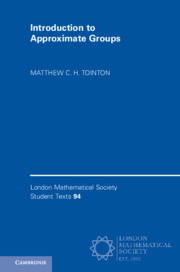Book contents
- Frontmatter
- Dedication
- Contents
- Preface
- 1 Introduction
- 2 Basic Concepts
- 3 Coset Progressions and Bohr Sets
- 4 Small Doubling in Abelian Groups
- 5 Nilpotent Groups, Commutators and Nilprogressions
- 6 Nilpotent Approximate Groups
- 7 Arbitrary Approximate Groups
- 8 Residually Nilpotent Approximate Groups
- 9 Soluble Approximate Subgroups of GLn(C)
- 10 Arbitrary Approximate Subgroups of GLn(C)
- 11 Applications to Growth in Groups
- References
- Index
11 - Applications to Growth in Groups
Published online by Cambridge University Press: 31 October 2019
- Frontmatter
- Dedication
- Contents
- Preface
- 1 Introduction
- 2 Basic Concepts
- 3 Coset Progressions and Bohr Sets
- 4 Small Doubling in Abelian Groups
- 5 Nilpotent Groups, Commutators and Nilprogressions
- 6 Nilpotent Approximate Groups
- 7 Arbitrary Approximate Groups
- 8 Residually Nilpotent Approximate Groups
- 9 Soluble Approximate Subgroups of GLn(C)
- 10 Arbitrary Approximate Subgroups of GLn(C)
- 11 Applications to Growth in Groups
- References
- Index
Summary
We present various applications of Breuillard, Green and Tao’s rough classification of finite approximate groups to groups of polynomial growth. We define polynomial, exponential and intermediate growth, and show that these concepts are stable under changes of generating set and passing to subgroups of finite index. We prove Breuillard, Green and Tao’s result that if a ball of large enough radius in a Cayley graph is of size polynomial in the radius then the underlying group is virtually nilpotent. We deduce that all larger balls also have polynomial bounds on their sizes. We guide the reader in the exercises to Breuillard and Tointon’s results that a finite group of large diameter admits large virtually nilpotent and virtually abelian quotients. We also prove the same authors’ result that a finite simple group has diameter bounded by a small power of the size of the group. We prove an isoperimetric inequality for finite groups due to Breuillard, Green and Tao. Finally, we give a brief high-level introduction to applications of approximate groups to the construction of expanders.
Keywords
- Type
- Chapter
- Information
- Introduction to Approximate Groups , pp. 178 - 197Publisher: Cambridge University PressPrint publication year: 2019

